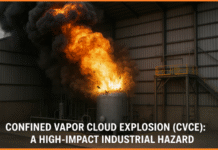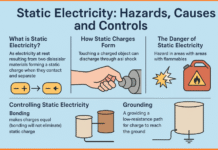Fire is a chemical process defined as the self-sustained oxidation of a fuel, accompanied by the release of heat and light. It is a powerful force that can be both beneficial and destructive. To understand fire behavior and how it can be controlled or extinguished, it’s essential to know the components that make it possible: the Fire Triangle and the more comprehensive Fire Tetrahedron.
Contents
🔺 The Fire Triangle
The Fire Triangle is a simple model that identifies the three essential elements required for a fire to ignite and sustain itself:
- Fuel – Any combustible material (solid, liquid, or gas) that can be burned.
- Ignition Source (Heat) – A source of heat sufficient to raise the fuel to its ignition temperature.
- Oxygen – Typically from the air (about 21% oxygen), which supports the chemical reactions involved in combustion.
If any one of these three elements is removed, a fire cannot start or will be extinguished. For example, removing the heat (cooling), cutting off the oxygen (smothering), or eliminating the fuel (starving) will break the fire triangle.
🔷 The Fire Tetrahedron
While the Fire Triangle explains the basic requirements for combustion, modern fire science has expanded on this with the Fire Tetrahedron, which adds a fourth component:
- Fuel
- Ignition Source (Heat)
- Oxygen
- Chemical Chain Reaction (CCR) – The continuous cycle of chemical reactions that sustain the combustion process.
The inclusion of the chemical chain reaction explains why some fires are especially difficult to extinguish, as this invisible reaction sustains the fire even when the other components are partially controlled.
🔥 Extinguishing Fire
To extinguish a fire, one or more sides of the Fire Tetrahedron must be disrupted:
- Cooling – Reducing the temperature (removing the heat), usually with water or another coolant.
- Smothering – Cutting off the oxygen supply using foam, CO₂, or fire blankets.
- Starving – Removing or isolating the fuel source.
- Interrupting the Chemical Chain Reaction – Using specialized chemical extinguishers (e.g., dry chemical agents) to disrupt the combustion reactions at a molecular level.
Understanding the Fire Triangle and Fire Tetrahedron is crucial for effective fire prevention, control, and firefighting. These models not only illustrate how fires start and continue to burn but also provide practical methods for extinguishment. Whether for household safety, industrial applications, or firefighting training, knowing these principles is key to managing fire risks and staying safe.





